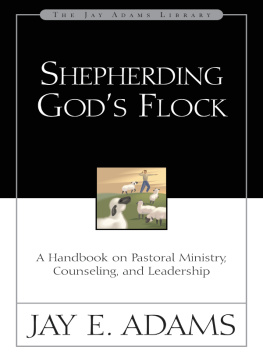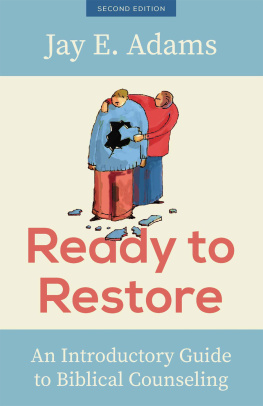To Skipa faithful friend, fellow counselor, and fruitful workman in the Word
The last 15 years have witnessed a profusion of well-meaning but ill-taught pastors and Christian workers attempting unsuccessfully to help others change. I get letters and phone calls from such workers all the time. When I go somewhere to speak, it is rare that people do not ask me for advice on how to help their friends and loved ones. Christians are buying books on counseling as if there were nothing else on the shelves. It seems as if the whole church has decided to do counseling.
It is encouraging that so many Christians are vitally interested in helping others. But try as they may, many run smack up against the hard realities, only to discover that their best intentions are no substitute for knowledge and skills. Though sincerely wanting to see change, they simply do not know how to bring it about. In order to help others, they first need help in understanding the counseling process itself. It is for such people that I have prepared this book as a guide to the process of effecting biblical change.
Cliff, a concerned Christian, has been counseling with Brad, a friend at work, who has confessed homosexual tendencies. Brad is not a Christian, and Cliff has plunged into the counseling without first confronting him with the gospel. As Cliffs efforts prove counterproductive, he wonders why he is unable to promote any real change. Cliffs ineffectiveness reflects a problem of order. He has gotten things out of sequence in the counseling process. Properly instructed about the process of counseling as laid out in Scripture, Cliff would have dealt with Brad much differently, beginning not with counseling, but with precounseling (i.e., evangelism).
Barbara has been served divorce papers by Phil, her husband of nine years. Both are professing Christians. Barbara doesnt want the divorce. But their church has never exercised church discipline, and, of course, she has never been instructed about what to do in such an event. The church has done nothing. Crushed and defeated, Barbara turns to her friend Mildred for advice and comfort. Although Mildred, a member of the same church, would like to help, she is equally untaught. So instead of pointing Barbara to Matthew 18:15ff., Mildred merely extends sympathy and tries to comfort Barbara by talking it out. Her well-meant efforts soon turn into pity parties and later degenerate further into daily gossip sessions where both of their husbands are turned slowly on a spit, over fires fueled by resentment.
Whenever well-meant help is not biblically directed, it does more harm than good. It amounts to bad advice, leading to harmful action. Or else it leaves the situation unchanged by misdirecting energy, so as to produce more problems rather than solutions.
The upshot of Mildreds counseling is that it encourages bitterness and resentment, rather than cultivating conditions favorable to reconciliation. Without realizing it, Mildred has substituted a worldly process for the biblical one. Had she known Gods process and how to use it, she would have proceeded very differently, probably with different results. The same could be said of Cliff and his counseling of Brad. Knowing and using the biblical process can make all the difference in the world: it can bring about change that honors God and helps others.
Some change comes swiftly, requiring minimal effort and little or no help from others. Other change comes hard and calls for the intervention of a counselor (Gal. 6:1). Since counselors are often stymied by the difficulties of bringing about the more stubborn sort of change, this book aims to set forth the scriptural ways and means of helping effect that kind of change.
Change of the easier sort often comes with simple biblical instruction, how-to guidance, and encouragement. Even such minimal assistance can be a problem to an erstwhile counselor who does not know the Scriptures well or how to implement them in particular situations. For such people, this book should afford more than ample information. But its focus is on the more difficult yet fairly common problems the average counselor encounters daily.
While touching on many aspects of counseling, this book does so from its own perspective. It is specifically designed to elucidate the process of counseling. I have often mentioned and illustrated that process, but not in the focused and systematic way that four-step biblical process is set forth here. Though ideas and procedures contained here may be found scattered throughout my other works, this book presents a fresh perspective not only on how to counsel, but also on what measures to take at what stages of counseling. It is a major effort to bring more ripened and mature thought to the counseling process, so that the average counselor will be able to use it in his day-to-day practice straight from the page.
These, creatively adapted, may be followed by instructors or by small groups using this textbook. More assignments than are necessary are given, allowing for choices and variety. Individuals, reading on their own, also will gain more from the book by doing the assignments.
May the God of all grace, Who has allowed me the opportunity once more to write, bless these efforts to help you help many others.
Jay E. Adams
Dean of the Institute of Pastoral Studies, The Christian Counseling and Educational Foundation
Director of Advanced Studies
Westminster Seminary in California
Counselors agree on few things. Over the years I have stressed that the proliferation of counseling and psychotherapeutic systems strongly evidences both confusion and conflict within psychological and psychiatric ranks. The plain fact is that no consensus is possible on the prevailing assumption that mans problems can be solved apart from Jesus Christ. As most counselors scoff at the biblical views of man, God, and the universe, one should not be surprised at Carl Rogerss admission that the field of counseling is in a state of chaos.
Given such disharmony, it might surprise you when I say that counselors of all stripes hold one point in common. No matter how divergent their dogmas, all counselorsChristians includedagree that the aim of counseling is to change people. Changewhether in the counselees thinking, feeling, behavior, attitude, sensitivity, awareness, or understandingis the goal of all counseling.
Because change is central to counseling and therefore vitally important, the Christian counselor must come to a scriptural understanding of change in all of its dimensionsits nature, goals, and process. Otherwise he might as well forget about helping others change, and when comparing ideas with counselors of a humanistic bent, he will have nothing better to offer. There is no excuse for being caught unprepared. In His Word, God has spoken definitively about change. But to become fully conversant with what He has said and to be able to organize and use biblical truth, it will be necessary for us to discuss both the process of change and its underlying theoretical principles. That we shall do in this book, but always with the focus on process.
Change versus Change
When we talk about changing people, what do we mean? Because counselors do not all have the same kind of change in mind, it is not strictly correct to say that they agree on the need for changing counselees. Just as the word automobile conveys strikingly different images to owners of new BMWs than to owners of third-hand Toyotas, so also counselors, who agree on the need for modification in counselees, may have vastly different ideas and attitudes concerning that change.
What we are talking about as Christians is change that goes far beyond minimal or incidental modifications in a persons behavior. The superficial change offered by secular counselors will not do. Substantial change requires the Holy Spirits alteration of the heart (ones inner life known only to God and oneself). Outward changes of any significance must begin there. Anything less is an unbiblical and inadequate view of change.
Next page














